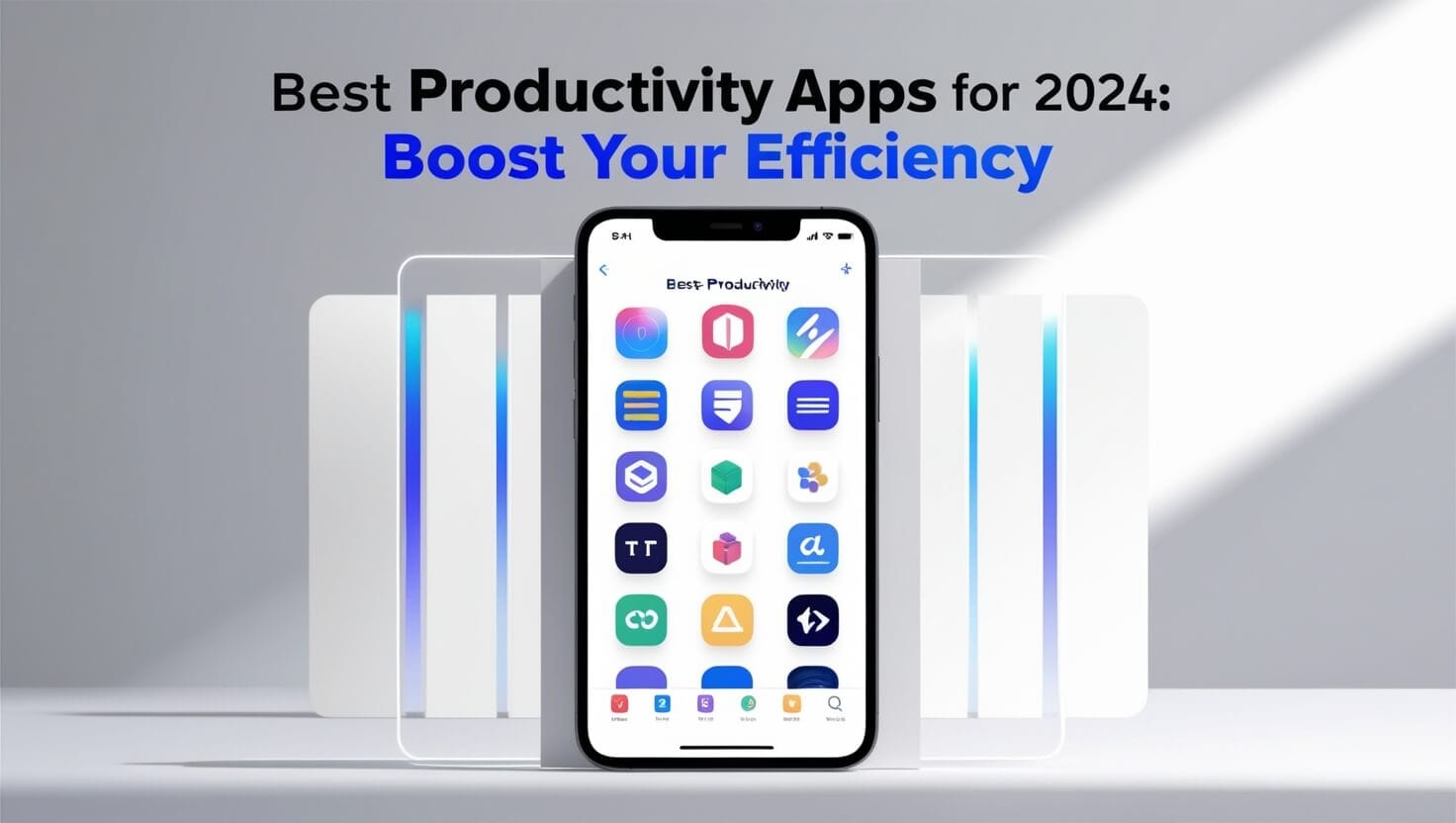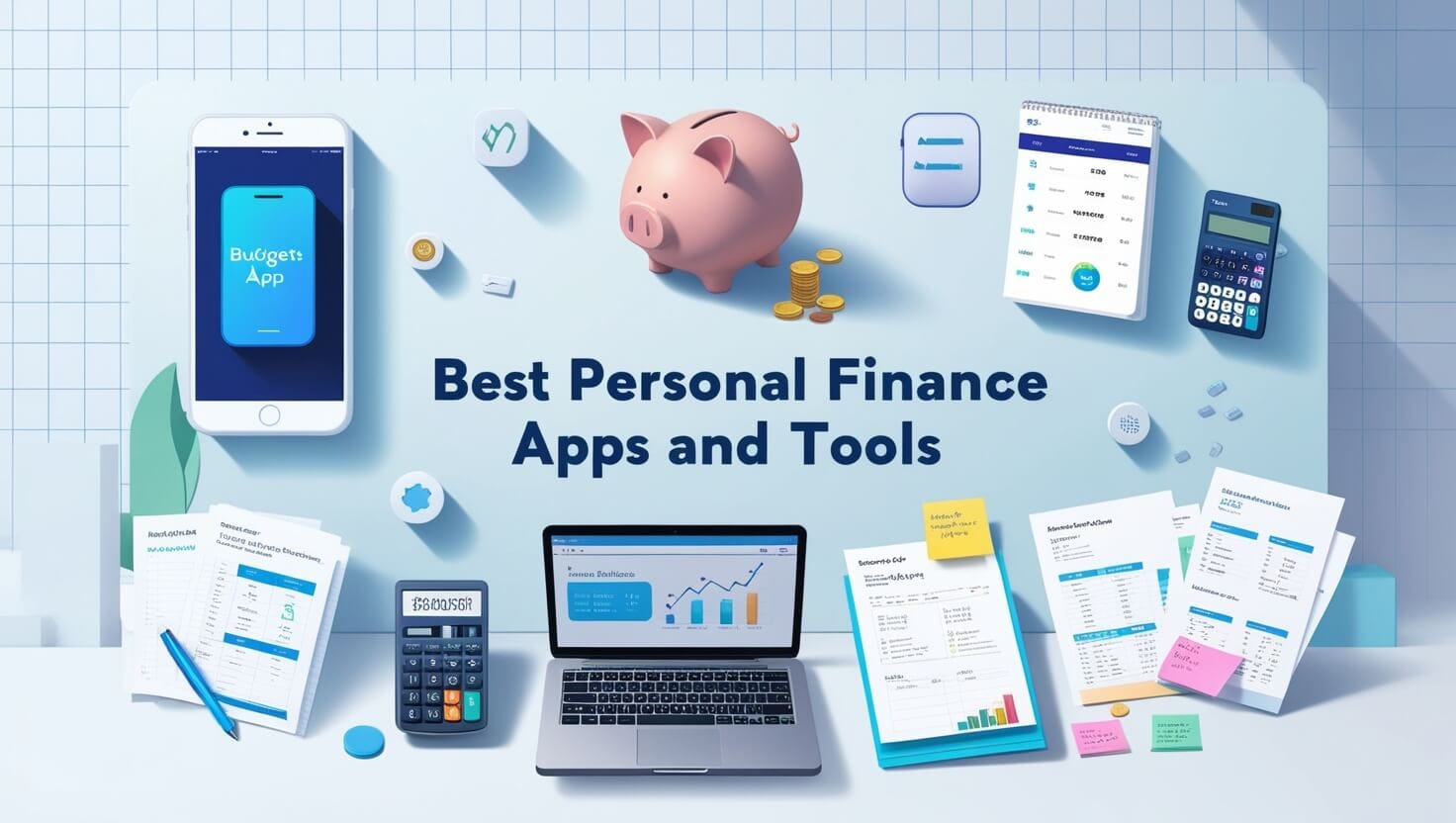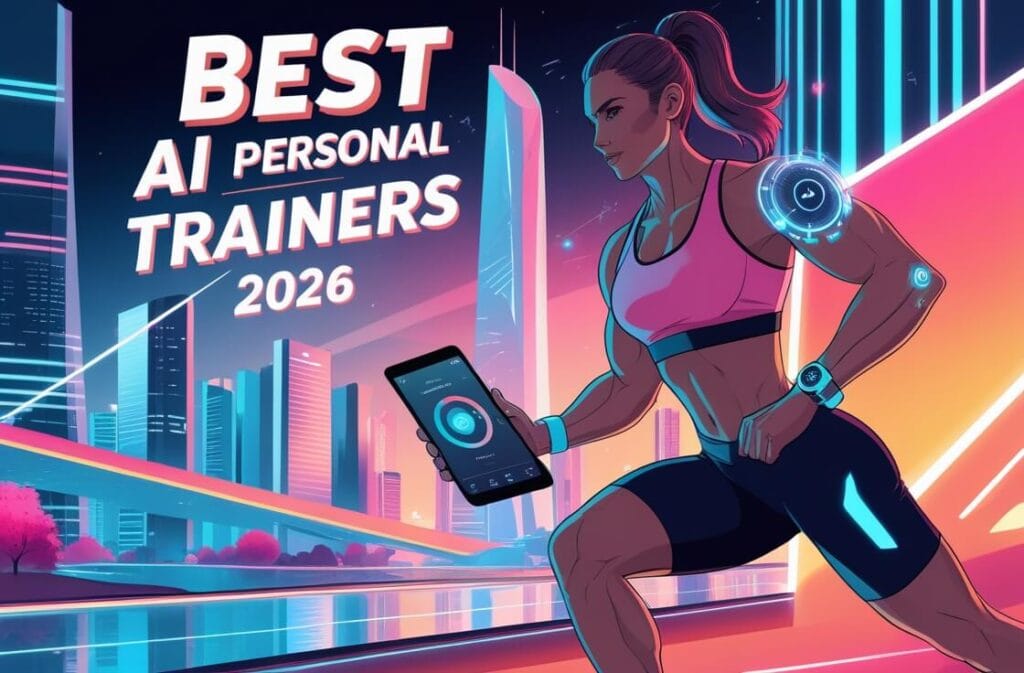
Looking for a personal trainer who’s available 24/7, never cancels sessions, and costs a fraction of traditional coaching? You’re not alone! The AI personal trainer market exploded in 2025, and honestly, I wish I’d jumped on this trend sooner. After spending thousands on in-person trainers who constantly rescheduled (or worse, made me feel guilty for missing a session), I finally gave AI fitness coaching a shot last year. Game changer.
Here’s something wild: a recent study showed that people using AI personal trainers stayed consistent with their workouts 73% more than those going solo. That’s huge! And get this – the average person saves around $1,200 annually by switching from traditional personal training to AI-powered fitness apps. I mean, when you break it down like that, it’s kind of a no-brainer.
But here’s the thing – not all AI personal trainers are created equal. Some are basically glorified workout timers, while others genuinely adapt to your form, energy levels, and progress like a real coach would. I’ve tested probably a dozen different platforms over the past year (yeah, my credit card wasn’t thrilled), and I’m gonna share everything I learned so you don’t waste time or money on the wrong one.
Best AI Personal Trainers for Strength Training and Muscle Building
If you’re trying to pack on muscle or get seriously strong, not just any AI personal trainer will cut it. Trust me, I learned this the hard way when I tried using a general fitness app for my bulk phase and basically spun my wheels for two months.
Fitbod

Fitbod is hands-down my top pick for AI-powered strength training. This app is smart – like, scary smart. It tracks every set, every rep, and every weight you lift, then uses that data to optimize your next workout. What I love is how it balances muscle group fatigue. If I destroy my legs on Monday, Fitbod knows not to program heavy squats again on Tuesday even if that was the original plan. The progressive overload is built in automatically, so you’re constantly pushing yourself without having to calculate percentages or deload weeks.
The app cost me about $80 for the year, which is basically what I used to pay for ONE session with a human trainer. And honestly? The programming was better. More consistent, more scientifically sound, and it never tried to sell me supplements I didn’t need.
Future

Future is another AI personal trainer that’s specifically killer for strength work, though it’s pricier at around $150 per month. But here’s why some people swear by it: you get an actual human coach who works WITH the AI system. The AI handles the data analysis and workout programming, while your human coach provides accountability and can answer questions. It’s like a hybrid approach that gives you the best of both worlds. I tried it for three months during a serious training block and the results were legit – I added 30 pounds to my bench press.
For powerlifting specifically, Boostcamp is an AI fitness coach that’s got tons of proven programs built in. You can run programs like 5/3/1, nSuns, or GZCLP, and the AI handles all the calculations and progression. It was perfect when I wanted to follow a structured powerlifting program without doing math between every set. Plus it’s free for basic features, which is awesome for beginners.
Key Considerations for Strength-Focused AI Personal Trainers:
- Progressive overload tracking and automatic weight recommendations
- Exercise variation to prevent plateaus and boredom
- Recovery monitoring and deload week programming
- Form checking specifically for compound lifts (squat, bench, deadlift)
- Volume and intensity management across training blocks
Here’s something I wish someone had told me earlier: AI personal trainers for strength training work best when you’re honest with the RPE (rate of perceived exertion) logging. The algorithms rely on your feedback to adjust properly. I was sandbagging my ratings at first because I thought it made me look tough, but I was actually making the programming less effective. Once I started rating things accurately, the AI could properly manage my fatigue and I started making way better gains.
One limitation I’ll mention – AI personal trainers can’t teach you complex movements from scratch as well as a human coach can. If you’ve never deadlifted before, I’d recommend getting at least a few sessions with a real trainer to learn the basics, then let your AI fitness coach handle the programming and progression from there. That’s what I did, and it worked out great.
Best AI Personal Trainers for Weight Loss and Fat Burning
Weight loss is where AI personal trainers really shine, in my opinion. The consistency and accountability features are just perfect for this goal. I dropped 25 pounds using AI coaching after years of yo-yo dieting, and it finally stuck because the approach was so personalized and sustainable.
Noom

Noom isn’t technically an AI personal trainer in the traditional sense, but it uses artificial intelligence to create behavioral change around food and exercise. The psychology-based approach was honestly what I needed more than just another workout plan. The AI coach asks you daily questions about your choices and helps identify patterns. Like, I didn’t realize I was emotionally eating every time I got stressed at work until Noom’s AI pointed out the correlation. Mind blown.
The cost is around $60 per month, which includes the AI coaching plus access to a human coach and support group. For weight loss specifically, I found this combo of AI and human support to be clutch.
Freeletics

Freeletics is a beast of an AI personal trainer for high-intensity workouts and fat burning. This app does NOT mess around – the workouts are brutal in the best way. The AI adapts based on how you perform, so if you’re crushing a workout, it might throw in an extra round. If you’re struggling, it scales back. I love that it pushed me harder than I would’ve pushed myself, which is exactly what I needed for fat loss.
What makes Freeletics special as an AI fitness coach is the huge exercise library and the fact you can do everything with just bodyweight. No gym needed. When I was traveling for work and trying to stay consistent with my weight loss, I could knock out a Freeletics session in my hotel room. The AI adjusted my training automatically based on my available equipment (aka none) and still kicked my butt.
Centr

Centr (Chris Hemsworth’s app) combines AI personal training with nutrition planning, which is killer for weight loss. You can’t out-train a bad diet, right? The AI creates meal plans based on your preferences and calorie targets, then adjusts your workouts to complement your nutrition. I found having everything in one ecosystem made it way easier to stay on track. The app costs about $30 per month, which is reasonable considering you get both training and meal planning.
Important Features for Weight Loss-Focused AI Personal Trainers:
- Calorie and macro tracking integration
- HIIT and metabolic conditioning workouts
- Cardio and strength training balance
- Habit tracking and behavioral coaching
- Progress photos and measurement tracking
- Community support and challenges
Here’s a mistake I made early on – I chose an AI personal trainer that focused only on exercise and ignored nutrition. I was working out consistently but not seeing the scale move because I was eating way too much. The most effective virtual personal trainers for weight loss address both sides of the equation. They help you understand that you can’t just exercise your way out of overeating.
One thing that really helped me was finding an AI fitness coach with flexible workout lengths. Some days I had 45 minutes, other days I could only squeeze in 15. The best AI personal trainers adapt to your available time while still keeping you in a calorie deficit through movement. That flexibility was huge for consistency, which is obviously the most important factor for weight loss.
The accountability features in weight loss-focused AI personal trainers are also next level. Daily check-ins, progress tracking, streak counters – all that gamification stuff that sounds cheesy actually works. My current AI coach sends me a notification every morning, and I weirdly don’t want to disappoint it even though it’s just an algorithm. Whatever works, right?
Best AI Personal Trainers for Home Workouts and Small Spaces
This is probably the most common situation people are in – wanting to work out at home without a ton of equipment. I live in a tiny apartment, and trust me, I’ve gotten creative with my training space (my coffee table has seen some things).
Tempo Studio

Tempo is the Cadillac of AI personal trainers for home use, but it’s also the most expensive. You’re looking at around $2,500 for the hardware (a tall mirror-like screen with built-in weights) plus a monthly subscription. But hear me out – if you have the budget, this thing is INCREDIBLE. The 3D motion tracking is so accurate it feels like you have a real trainer watching you. It counts reps automatically, checks your form from multiple angles, and the weight recommendations are spot-on.
I used one at my friend’s place for a few weeks, and I was genuinely impressed. The AI fitness coach could tell when I was compensating with the wrong muscles and would call it out immediately. Like, “you’re using your lower back instead of your glutes on that deadlift” – that level of specific feedback. For someone training at home who’s worried about developing bad habits without a spotter, Tempo is gold.
Forme Life

Forme is similar to Tempo but a bit more affordable and takes up less space. It’s like a smart mirror that becomes your AI personal trainer. The form correction is solid, and it integrates with other fitness apps you might already use. I like that it has both strength and yoga/pilates classes, so you’re not limited to one training style.
But let’s be real – not everyone can drop thousands on fancy equipment. That’s where apps shine.
Caliber

Caliber is an AI fitness coach that I absolutely love for small spaces. It’s like having a personal trainer in your pocket, and the basic version is free (premium is around $30/month). The app asks what equipment you have available – even if it’s just resistance bands and a yoga mat – and builds programs around that. The AI adjusts exercises based on your space limitations too. If you don’t have room for jumping jacks, it’ll sub in something else that works the same muscle groups.
What impressed me most about Caliber was how the AI personal trainer adapted when I told it I only had a 6×6 foot workout space (literally just the area between my couch and TV). It programmed workouts that didn’t require me to move around much, which sounds limiting but the sessions were still challenging as hell.
Affordable Home Workout AI Personal Trainers:
- Jefit: Great for tracking strength workouts with minimal equipment, strong community features
- Sworkit: Creates workouts based on available time and space, no equipment needed
- Nike Training Club: Free AI-powered workout recommendations, huge exercise library
- Aaptiv: Audio-based coaching with AI playlist creation, perfect for small spaces
Equipment Recommendations for Home AI Training:
- Adjustable dumbbells (game changer for small spaces)
- Resistance bands with different tension levels
- Yoga mat (duh, but people forget)
- Pull-up bar (if you have a doorframe that works)
- Stability ball (doubles as extra seating, very apartment-friendly)
Here’s a pro tip I learned the hard way: tell your AI personal trainer the TRUTH about your available equipment and space. I was embarrassed to admit I only had 5-pound dumbbells at first, so I said I had heavier weights. The workouts were programmed too hard, I got discouraged, and almost quit. Once I was honest, the AI created a progressive plan that started where I actually was, and I made way better progress.
The best AI fitness coaches for home use also include modification options within workouts. Like, if an exercise is too loud for apartment living (I learned this at 6 AM when my downstairs neighbor started banging on the ceiling during jump squats), you can swap it for a quieter alternative without derailing your whole session.
Best AI Personal Trainers for Running and Cardio Training
I’ll be honest – I’m not naturally a runner. I’m the person who used to say “I only run if something’s chasing me.” But AI personal trainers changed my relationship with cardio completely by making it actually strategic instead of just mindless suffering.
Runna

Runna is hands-down the best AI personal trainer specifically for runners. It’s like having a running coach who’s actually studied your training data instead of just giving you a generic plan they give everyone. The app costs about $15/month, which is nothing compared to running coaches who charge $150+ monthly.
What makes Runna special is how it builds proper periodization into your training. The AI personal trainer plans your base building, speed work, tempo runs, and recovery runs in a way that makes sense together. I used to just go out and run the same pace every time – no wonder I never got faster! Runna explained exactly why each workout mattered and how they fit together. The progress I made in three months was honestly shocking.
The voice coaching during runs is clutch too. The AI coach tells you when to speed up or slow down based on your heart rate zones and the workout plan. I don’t have to keep checking my watch, I just listen to the cues. It’s like having someone running alongside you who actually knows what they’re talking about.
Zwift

Zwift for running (they started with cycling but added running) is an AI-powered platform that’s super fun if you have a treadmill. You run through virtual worlds while the AI adjusts your training plan based on performance. It’s honestly the only thing that makes treadmill running bearable for me. The social features are great too – you can run “with” other people virtually, which sounds dorky but is surprisingly motivating.
The cost is around $15/month plus you obviously need a treadmill, so it’s not for everyone. But if you’re stuck running indoors due to weather or safety concerns, this AI fitness coach makes it way less boring.
For General Cardio Training Beyond Running:
Apple Fitness+

Apple Fitness+ has solid AI-powered workout recommendations if you’re in the Apple ecosystem. The smart suggestions based on your activity patterns are surprisingly good. Like, if I’ve been doing a lot of strength training, it’ll suggest a recovery-focused yoga class. If I’ve been slacking on cardio, it’ll push HIIT workouts. The integration with Apple Watch makes the AI personal trainer features work seamlessly.
Peloton

Peloton (yes, they have an app without the bike) uses AI to recommend classes based on your fitness level and what you’ve done recently. I was skeptical about Peloton because of the price ($44/month for digital), but the variety of cardio options is insane. The AI learns what instructors you vibe with and suggests their classes, which I actually found really helpful because not all coaching styles work for everyone.
Important Features for Cardio-Focused AI Personal Trainers:
- Heart rate zone training and monitoring
- Interval training customization
- Progressive distance or time increases
- Recovery day programming
- Cross-training integration
- Race preparation plans (if applicable)
Here’s what I wish I’d known earlier about AI personal trainers for cardio: they’re only as good as the data you give them. If you’re not tracking your heart rate consistently, the AI can’t properly gauge your effort level and adapt your training. I ran without a heart rate monitor for the first month and the workouts felt randomly hard or easy. Once I started wearing my watch consistently, the AI personal trainer could actually program intelligently based on my true fitness level.
Zone 2 training was something my AI fitness coach basically forced me to learn about, and it changed everything. I was always running too hard, never letting my aerobic base develop. The AI keeps you honest about your pace – if you’re supposed to be doing easy running, it’ll tell you to slow down even when your ego wants to speed up. That discipline is exactly what I needed.
Best Budget-Friendly AI Personal Trainers
Look, not everyone has hundreds of dollars a month to spend on fitness tech. I certainly didn’t when I started! The good news is there are actually some solid AI personal trainers that won’t destroy your bank account.
FitOn

FitOn is completely free and uses AI to recommend workouts based on your goals and preferences. Seriously, free – I kept waiting for the catch but there really isn’t one beyond some optional in-app purchases. The AI personal trainer analyzes what workouts you complete and suggests progressively harder challenges. The exercise library is huge, featuring celebrity trainers, and the form instruction is genuinely helpful.
I used FitOn for like six months when I was broke, and honestly got great results. The only downside is the AI features aren’t as advanced as paid options – it’s more like smart recommendations than truly adaptive programming. But for free? Can’t beat it.
Nike Training Club is another mostly free option that punches way above its weight class. The AI-powered personalization is impressive for something that doesn’t cost anything. Nike’s AI personal trainer creates custom plans based on your goals, and the instruction quality is top-notch. I mean, it’s Nike – they have resources to make really good content.
The adaptive training programs adjust if you miss workouts or need more recovery. I appreciated that it didn’t just guilt trip me when life got busy; it actually modified the plan to be realistic. That’s smart AI programming right there.
Affordable Paid Options That Are Worth It:
Caliber (mentioned earlier) is only $30/month for premium, and you get SO much more personalization than free apps. The AI personal trainer actually messages you asking about your workouts, energy levels, and any issues you’re having. It feels way more like having an actual coach checking in versus just using an algorithm. I think this is the sweet spot for price-to-value.
Jefit

Jetfit is like $7/month, which is basically nothing. It’s primarily a workout tracker, but the AI creates programs based on your lifting data and suggests exercises to balance out your training. If you’re the type who knows what you want to do but needs help organizing it intelligently, this AI fitness coach is perfect. The exercise database is massive – over 1,400 exercises with instructions.
Comparison Shopping Tips for Budget AI Personal Trainers:
- Check if there’s a free trial before committing (most have at least a week)
- Look for annual pricing – usually saves 20-30% versus monthly
- See if your health insurance offers fitness app reimbursements (some do!)
- Check if family or student discounts are available
- Consider starting free and upgrading only when you hit limitations
Here’s my strategy: I started with completely free AI personal trainers to prove to myself I’d actually use them consistently. After three months of regular use, I upgraded to a paid AI fitness coach because I knew I’d get my money’s worth. That’s way smarter than immediately dropping $150/month on something you might abandon after two weeks.
One thing about budget AI personal trainers – they often lack some of the fancy form-checking technology that expensive options have. That’s fine if you already know proper exercise technique, but if you’re a beginner, it might be worth investing in at least a few sessions with a human trainer to learn the basics first. Then let the budget-friendly AI coach handle your ongoing programming.
The community features in free AI personal trainers are usually where they make up for lacking advanced tech. Apps like FitOn have active user communities where people share tips, challenges, and motivation. That social accountability can be just as valuable as sophisticated algorithms sometimes.
What Are AI Personal Trainers and How Do They Actually Work?
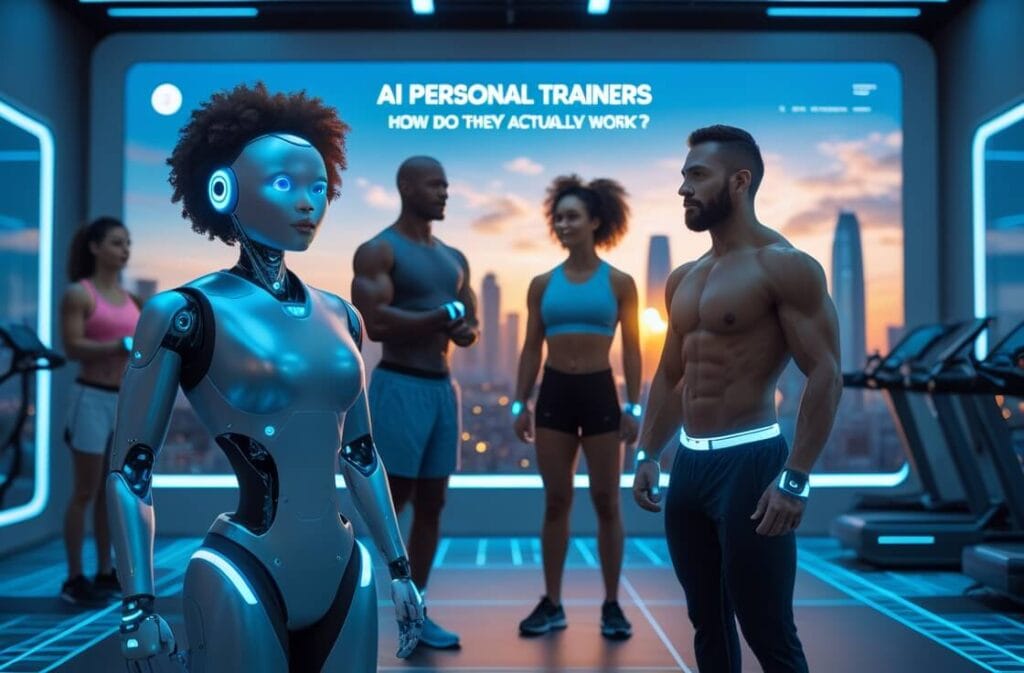
Okay, so when I first heard about AI personal trainers, I thought it was just some fancy marketing term for workout apps. Boy, was I wrong!
AI personal trainers use machine learning algorithms and artificial intelligence to create personalized workout plans, track your progress, and adapt your training based on real-time data. It’s like having a coach who actually remembers every single rep you’ve done, every plateau you’ve hit, and exactly how your body responds to different exercises. And unlike my old trainer Brad (sorry Brad), they don’t forget that you have a bad knee.
The technology behind these digital fitness coaches is pretty impressive when you dig into it. Most AI personal trainers use computer vision to analyze your form through your phone’s camera. They can spot if your squat depth is off or if your plank form is sagging – stuff I never even noticed about myself until the app pointed it out. Some of them gave me feedback that was honestly more detailed than what I got from human trainers.
What really sets modern AI fitness coaches apart is their ability to learn from millions of users. They’re constantly getting smarter by analyzing what works and what doesn’t across thousands of fitness journeys. My AI trainer noticed patterns in my energy levels that I hadn’t even connected – like how I consistently perform better on lower-body workouts in the afternoon versus morning. Wild stuff.
The coolest part? These virtual personal trainers integrate with your smartwatch, fitness tracker, and even your sleep data. So if you had a rough night’s sleep, your AI personal trainer might automatically adjust your workout intensity for the day. I remember one morning after barely sleeping because my neighbor’s car alarm went off at 3 AM, and my app actually suggested a lighter yoga session instead of the brutal HIIT workout I had scheduled. It knew before I did that I needed recovery!
Here’s what typically happens behind the scenes:
- Initial Assessment: The AI personal trainer asks about your fitness level, goals, any injuries, and available equipment
- Workout Generation: Algorithms create a customized program based on exercise science principles and your specific needs
- Real-Time Monitoring: Computer vision and sensor data track your movements and performance
- Adaptive Learning: The system adjusts future workouts based on your progress, form quality, and recovery patterns
- Continuous Optimization: Machine learning improves recommendations as it gathers more data about your preferences and results
But let’s be real – AI personal trainers aren’t perfect. They can’t physically spot you during a heavy bench press, and they definitely can’t give you that motivational slap on the back when you’re crushing it. What they CAN do is provide consistent, science-based guidance that’s personalized to you at a price point that makes sense.
Top Features to Look for in AI Personal Trainers
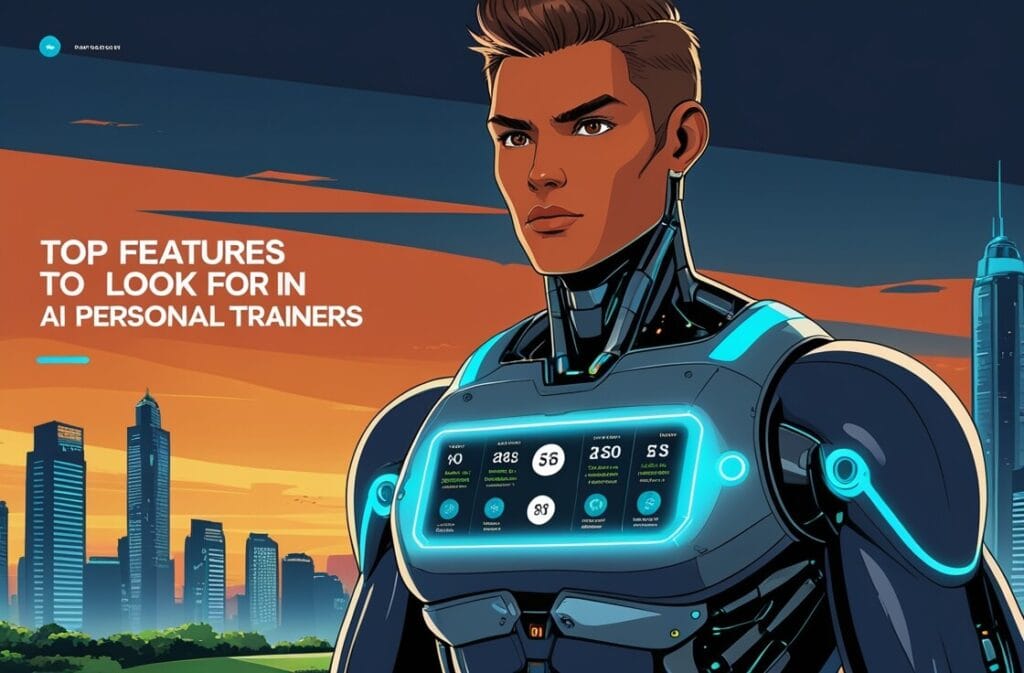
After trying way too many AI fitness apps (seriously, my phone’s home screen was just workout apps for like three months), I figured out what actually matters versus what’s just flashy marketing.
Form correction technology is absolutely number one on my list. I can’t stress this enough! The difference between an AI personal trainer that just counts reps versus one that actually analyzes your form is massive. I was doing lunges wrong for YEARS – my knee was going too far forward – and no human trainer ever caught it. But my AI coach flagged it immediately with a little red outline showing exactly where my form broke down. That feature alone probably saved me from a knee injury.
Personalization depth is another huge factor that separates the good AI personal trainers from the mediocre ones. Some apps just give you cookie-cutter programs with your name slapped on top. The really good ones? They adjust based on how you’re actually performing. Like, if you’re breezing through your squats but struggling with upper body stuff, a quality AI fitness coach will rebalance your program automatically.
Here’s what I look for now when evaluating AI personal trainers:
Must-Have Features:
- Real-time form analysis using computer vision technology
- Adaptive workout programming that changes based on your progress
- Integration with wearable devices and fitness trackers
- Voice coaching and verbal cues during exercises
- Detailed performance analytics and progress tracking
- Exercise modification options for injuries or equipment limitations
Nice-to-Have Features:
- Social features to connect with other users
- Nutrition tracking and meal planning integration
- Recovery and mobility-focused workouts
- Challenge modes and gamification elements
- Multiple trainer personality options (some people love drill sergeant mode, others prefer gentle encouragement)
The interface matters more than you’d think too. I tried one AI personal trainer that had amazing technology but the worst user experience – like, I literally couldn’t figure out how to log a completed workout. It was frustrating as hell. The best virtual workout assistants have clean, intuitive interfaces where everything just makes sense without needing a tutorial.
Voice coaching quality is something I initially overlooked but it became super important. Some AI personal trainers sound robotic and annoying, while others have really natural-sounding coaches that actually motivate you. I prefer the ones that give specific form cues like “drive through your heels” instead of just counting down “3… 2… 1…” The context matters!
One feature that surprised me with how useful it was: the ability to rate each exercise and provide feedback. After a few weeks, my AI fitness coach figured out that I hate burpees (join the club, right?) and started subbing them with other high-intensity movements that I actually enjoyed. That level of customization kept me from getting bored and quitting.
AI Personal Trainers vs Traditional Personal Training: Making the Right Choice
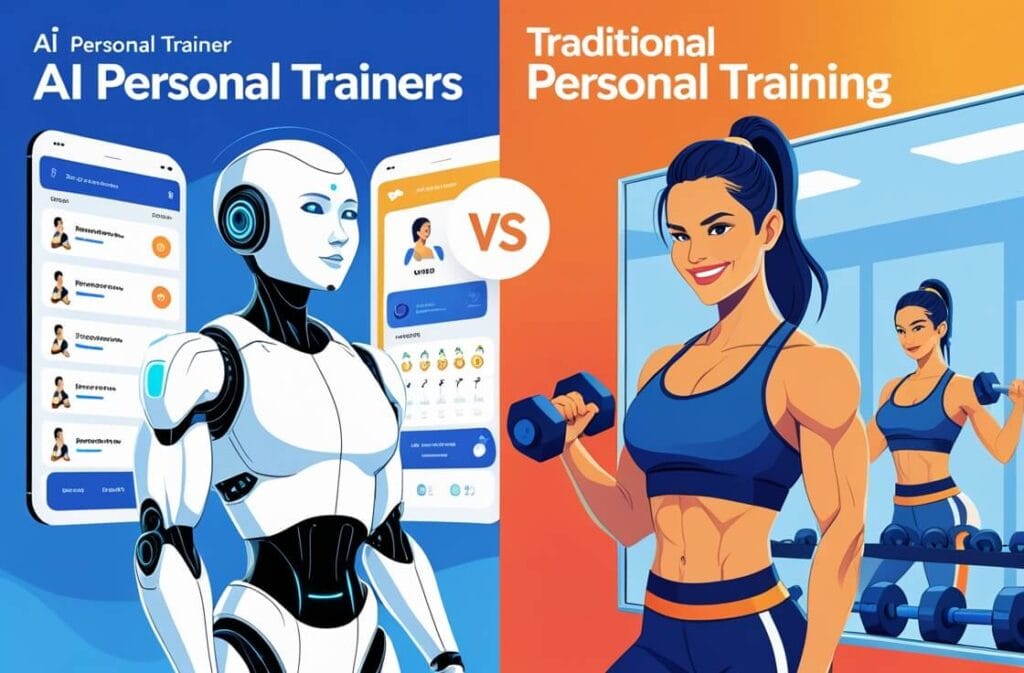
Okay, real talk time. I’ve spent money on both traditional personal trainers and AI fitness coaches, and they each have their place. Neither is universally better – it totally depends on your situation and what you need.
When Traditional Personal Training Wins:
Physical presence matters for some people. My friend Sarah absolutely needs another human being in the room to stay motivated. She’s tried every AI personal trainer under the sun and just doesn’t stick with it. But put her in front of a real trainer twice a week? She crushes it. There’s no shame in knowing what works for you.
Learning complex movements is way easier with a human coach there to physically adjust your position. When I was learning Olympic lifts, there’s no way an AI personal trainer could’ve given me the same quality feedback. My coach could see little compensations in real-time and correct them instantly. That hands-on teaching is hard to replicate digitally.
When AI Personal Trainers Win:
Consistency is where AI fitness coaches absolutely dominate. My traditional trainer canceled on me constantly – sick kid, flat tire, double-booked clients. Stuff happens, I get it, but it killed my momentum. My AI personal trainer? Available every single day, whenever I want, no excuses.
Cost is obviously huge. I was paying $75 per session for traditional training, seeing my trainer 2-3 times per week. That’s over $600 monthly versus like $30-40 for most AI personal trainers that give me daily workouts. The math is pretty simple.
Data tracking and progress analysis is something AI absolutely destroys human trainers at. My old trainer kept notes in a little notebook, which was cute but not exactly precise. My AI fitness coach tracks every rep, every set, every weight increment, then uses that data to optimize future workouts. It remembers way more than any human could.
Hybrid Approach (My Current Strategy):
I do mostly AI personal trainer workouts but see a human coach once monthly for technique checks and program reviews. This gives me the consistency and affordability of AI training with occasional expert human feedback. It’s the best of both worlds and costs me about $120/month total versus $600+ for all traditional training.
Some premium AI personal trainers like Future actually include human coaches working alongside the AI, which is brilliant. The AI handles programming and tracking, while the human provides motivation and answers questions. That collaborative approach makes so much sense.
Key Decision Factors:
- Budget: If money’s tight, AI personal trainers are the obvious choice
- Learning curve: Complete beginners often benefit from human instruction initially
- Motivation style: Some people need human accountability, others prefer digital
- Schedule: AI fitness coaches offer way more flexibility
- Goals: Complex athletic training might need human expertise; general fitness works great with AI
- Tech comfort: If you hate technology, forcing yourself to use AI personal trainers will just create frustration
Here’s something I learned: you can actually use AI personal trainers to make traditional training more affordable. Work with a human trainer every few weeks for form checks and program design, then use an AI fitness coach to execute the plan between sessions. My trainer actually suggested this approach and we both loved it – I got expert guidance without the crazy expense, and he could serve more clients.
The social aspect is one thing AI personal trainers can’t fully replicate yet. Training with a human creates a relationship – they know about your life, your struggles, what motivates you. Some AI coaches try to mimic this with chat features, but it’s not quite the same. If that connection matters to you, factor it into your decision.
How to Get Started with Your First AI Personal Trainer
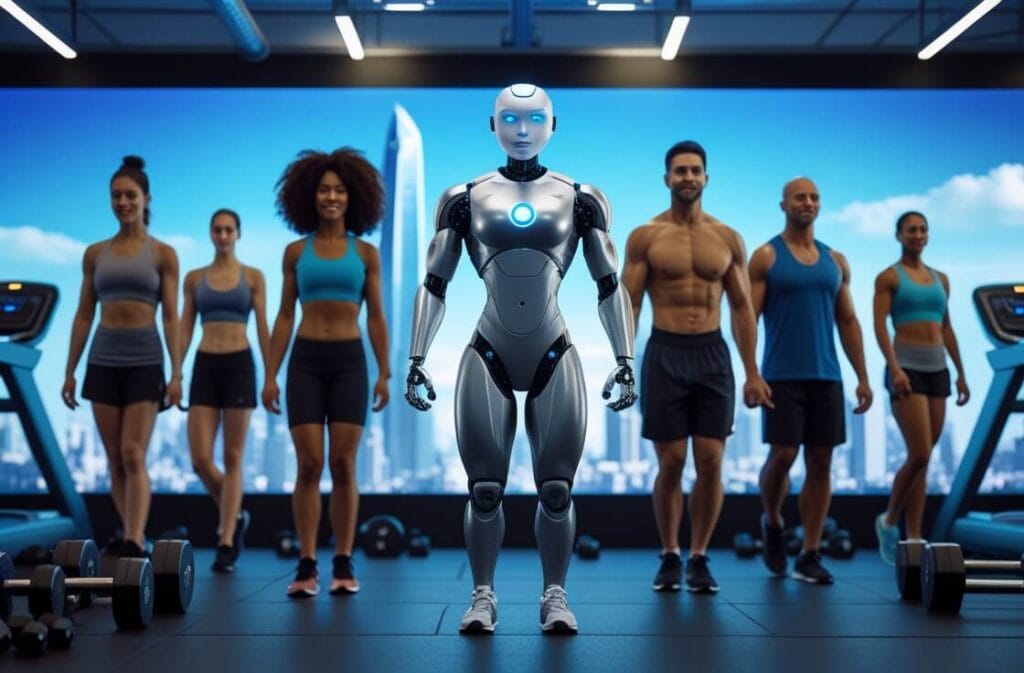
Alright, you’re convinced – you want to try an AI personal trainer. But where do you actually start? I remember feeling totally overwhelmed by all the options when I first looked into this.
Step 1: Define Your Primary Goal
The biggest mistake I see people make is trying to do everything at once. You can’t simultaneously maximize muscle gain, run a marathon, and lose 50 pounds. Pick ONE primary goal for your first 8-12 weeks with an AI personal trainer. You can always adjust later.
My first goal was dead simple: consistently work out 4 times per week for three months. I didn’t even care what the workouts were or what results I got – I just wanted to build the habit. That clarity made choosing an AI fitness coach way easier because I could focus on user experience and accessibility rather than getting lost in feature comparisons.
Step 2: Assess Your Situation
Before downloading every AI personal trainer app, honestly evaluate:
- What equipment do you have access to?
- How much time can you realistically dedicate per workout?
- What’s your actual fitness starting point? (Be honest!)
- Do you have any injuries or limitations?
- What’s your budget?
I spent two weeks “researching” (aka procrastinating) when I should’ve just spent 10 minutes answering these questions and picking something. The AI personal trainer doesn’t have to be perfect – it just has to be good enough to get you started.
Step 3: Start with a Free Trial
Almost every AI fitness coach offers some kind of trial period. Use it! But here’s the key: actually commit to completing workouts during the trial. Don’t just open the app, poke around, and form an opinion based on the interface. Do at least 5-7 workouts before deciding.
I almost dismissed my now-favorite AI personal trainer because the initial onboarding questions felt too long. But once I actually started training with it, I realized those detailed questions were why the programming was so good. Give it a real chance.
Step 4: Complete the Initial Assessment Honestly
When your AI personal trainer asks about your fitness level, don’t inflate it to seem impressive. Nobody’s judging you – it’s an algorithm! I said I could do 20 push-ups when I could barely do 5, and my first workout humbled me REAL quick. The AI adjusted after seeing my actual performance, but I wasted that first session being frustrated and sore.
Be specific about injuries and limitations too. If you have a bad shoulder, TELL THE APP. AI personal trainers can program around issues, but only if they know about them.
Step 5: Commit to 4-6 Weeks Minimum
You won’t see dramatic results in week one. The AI personal trainer needs time to learn your patterns and adapt the programming. And your body needs time to adapt to the training stimulus. I almost quit after two weeks because I wasn’t seeing changes, but I’m so glad I stuck with it.
Set calendar reminders for your workouts. Treat them like actual appointments. The flexibility of AI fitness coaches is both a blessing and a curse – it’s easy to skip when there’s no human expecting you to show up.
Realistic Expectations for Your First Month:
- Week 1: You’ll be sore and figuring out the app interface
- Week 2: Movements start feeling more natural, soreness decreases
- Week 3: You’ll notice energy level improvements and better sleep
- Week 4: Visible progress in either strength, endurance, or appearance (subtle but there)
Common Beginner Mistakes with AI Personal Trainers:
Don’t skip the warm-ups and cool-downs! I know it’s tempting when you’re short on time, but the AI programs them for a reason. I pulled a hamstring because I jumped straight into sprints without warming up properly. Learned that lesson the hard way.
Don’t ignore the rest days. Your AI personal trainer schedules recovery time based on science and your personal data. Overriding it to add extra workouts seems hardcore but actually sabotages your progress. Recovery is when adaptation happens.
Don’t expect the AI to read your mind. If something hurts (not tired sore, but actually hurts), stop and modify. The AI fitness coach will adapt if you communicate through the app’s feedback features. Most have options to rate exercises or flag movements that don’t work for you.
Pro Tips for Success:
- Take progress photos even if you hate them (you’ll want them later)
- Log your workouts consistently so the AI has good data
- Join the app’s community if it has one
- Don’t compare your chapter 1 to someone else’s chapter 20
- Celebrate small wins – completed your first week? That’s huge!
If the first AI personal trainer you try doesn’t click after giving it a fair shot, that’s okay! Try a different one. I went through three before finding my match. They’re all using similar technology but with different approaches, and sometimes it’s just about finding the right fit for your personality and preferences.
The Future of AI Personal Trainers: What’s Coming in 2026 and Beyond
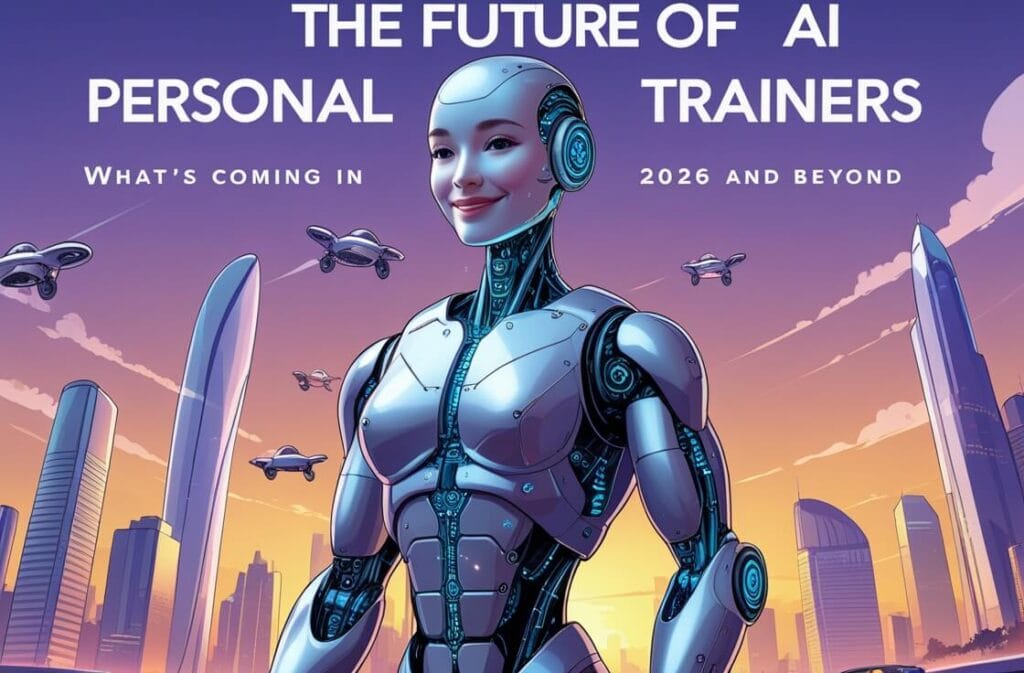
The AI fitness industry is moving FAST, and honestly, what’s coming next is kind of mind-blowing. I’ve been following the tech developments because I’m a nerd like that, and 2026 is going to be wild.
Improved Biometric Integration
The next generation of AI personal trainers will integrate way more health data. We’re talking continuous glucose monitoring, sleep stage analysis, hormonal cycle tracking, and even stress biomarkers. Your AI fitness coach will know if you’re under-recovered before you even feel it.
I tested a beta version that connected to my blood glucose monitor, and it was crazy how accurately the AI personal trainer could predict my energy availability for workouts. On days when my glucose was unstable, it automatically programmed lighter sessions. That level of personalization is becoming standard.
Advanced AR and VR Training
Augmented reality AI personal trainers are getting GOOD. Imagine putting on AR glasses and seeing a holographic coach demonstrating exercises right in front of you, with real-time form corrections overlaid on your body. It sounds like science fiction, but several companies are launching this in 2026.
Virtual reality fitness with AI coaching is also exploding. You can box against AI opponents that adapt to your skill level, or do strength training in virtual environments that make you forget you’re working out. My friend has a VR setup with an AI personal trainer, and I tried it – the time flew by way faster than traditional workouts.
AI Personal Trainers with Emotional Intelligence
This is where it gets interesting. New AI fitness coaches are incorporating emotional recognition technology. They can analyze your voice tone, facial expressions, and response patterns to gauge your mental state and adjust accordingly. If you’re stressed, the AI might suggest a restorative yoga session instead of intense training, even if the program called for HIIT.
I’m both excited and slightly creeped out by this, honestly. But from a training effectiveness standpoint, it makes total sense. Human trainers pick up on emotional cues naturally – now AI personal trainers are learning to do the same.
Predictive Injury Prevention
Machine learning models are getting scary good at predicting injuries before they happen. Future AI personal trainers will analyze movement patterns, volume accumulation, recovery metrics, and thousands of other data points to warn you when injury risk is elevated.
One AI fitness platform I follow is claiming their system can predict overuse injuries with 87% accuracy up to two weeks in advance. That’s huge! Imagine your AI personal trainer telling you “hey, your training load this week puts you at high risk for a shoulder strain, let’s modify these exercises” before anything goes wrong.
Hyper-Personalized Nutrition Integration
The line between AI personal trainers and nutrition coaches is basically disappearing. 2026 platforms are combining both with genetic data, microbiome analysis, and real-time metabolic feedback. Your AI fitness coach will know exactly what to eat, when to eat it, and how it affects your training.
I’m particularly excited about AI that can adjust your nutrition dynamically based on your workout performance. Like, if you crushed your leg day, the AI might suggest higher carb intake that evening to optimize recovery. That level of precision used to require expensive sports nutritionists.
Social and Community Features
AI personal trainers are getting better at connecting users in meaningful ways. Instead of just generic leaderboards, the AI will match you with training partners who have similar goals, schedules, and fitness levels. Some platforms are even creating virtual training groups where everyone follows complementary programs designed by AI to work well together.
Challenges and Concerns:
Privacy is obviously a big question. The more data these AI personal trainers collect, the more we need to think about who has access to it and how it’s used. I’m all for personalization, but I don’t love the idea of my workout data being sold to insurance companies or advertisers.
The human element might get lost if we’re not careful. There’s value in human connection and empathy that AI fitness coaches can’t fully replicate (yet). The best future scenario probably involves AI and human trainers working together, not AI replacing humans entirely.
Predictions for the AI Personal Trainer Market:
By late 2026, I think we’ll see AI personal trainers becoming standard in corporate wellness programs. Companies are realizing that giving employees access to AI fitness coaching is way more cost-effective than traditional gym memberships, and the data shows better engagement rates.
The technology will become more accessible to people with disabilities. AI personal trainers can already modify exercises, but future versions will have specialized programming for different mobility levels, chronic conditions, and adaptive fitness needs. That’s probably the most exciting development to me – making quality coaching available to everyone, not just able-bodied athletes.
Common Questions and Concerns About AI Personal Trainers
After talking to like a hundred people about my experience with AI fitness coaches, I keep hearing the same questions and concerns. Let me address the big ones.
“Can AI Personal Trainers Really Replace Human Trainers?”
Short answer: for most people, yes. For everyone? No.
If you’re a general fitness enthusiast who wants to get stronger, lose weight, or just stay healthy, AI personal trainers absolutely can meet your needs. The programming is solid, the form feedback is getting really good, and the cost savings are massive.
But if you’re an elite athlete, need serious rehab work, or have complex health issues, you probably still need human expertise. At least for now. I think the sweet spot is using AI personal trainers for day-to-day programming and bringing in human coaches for specialized needs.
“Will My Form Actually Be Safe Without a Spotter?”
This was my biggest concern initially. The form analysis technology in modern AI fitness coaches is actually impressively accurate for most exercises. But here’s the thing – it’s not perfect.
For heavy compound lifts like bench press or squats with significant weight, having a physical spotter is still important for safety reasons. The AI personal trainer can check your form and warn you about issues, but it can’t catch a barbell if you fail. Use safety equipment (like squat racks with safety bars) and be smart about your weight selection.
For bodyweight exercises, resistance bands, and lighter weights, AI form checking is totally sufficient. I’ve prevented several injuries because my AI personal trainer caught form issues I wasn’t aware of.
“What If I Don’t Have a Lot of Workout Experience?”
Actually, AI personal trainers are GREAT for beginners! They’re patient, never judgmental, and explain things clearly. You can watch exercise demonstrations as many times as you need without feeling dumb.
I was super out of shape when I started, and my AI fitness coach met me where I was. No shame, no pressure – just gradual progression from beginner-level movements to more advanced stuff. In some ways, it was easier than working with a human trainer because I didn’t feel self-conscious.
“How Much Technical Knowledge Do I Need?”
If you can use a smartphone, you can use an AI personal trainer. Seriously, the interfaces are designed to be intuitive. My 60-year-old mom uses one and she barely knows how to send text messages.
Most AI fitness coaches have tutorial videos for the app itself, not just for exercises. And customer support is usually pretty responsive if you get stuck.
“What About Accountability? Won’t I Just Skip Workouts?”
This is super individual. Some people need external accountability from another human, and that’s totally valid. But AI personal trainers actually have some clever tricks for keeping you consistent:
- Streak tracking (I don’t want to break my 47-day streak, you know?)
- Push notifications at your usual workout times
- Visual progress charts that show what you’ll lose if you stop
- Virtual rewards and achievement badges (yes, they’re cheesy but they work)
- Some AI personal trainers even have text check-ins that feel surprisingly personal
I’m actually MORE consistent with my AI fitness coach than I was with human trainers because I’m not relying on someone else’s schedule. The accountability is internal rather than external, which is ultimately more sustainable anyway.
“Are AI Personal Trainers Just for Young Tech People?”
Hell no! I’ve seen people from their 20s to their 70s using AI fitness coaching successfully. The tech adapts to your comfort level – you don’t need to be a tech wizard.
Actually, older adults sometimes benefit MORE from AI personal trainers because the programming can be specifically tailored for joint health, bone density, balance, and mobility. Traditional group fitness classes or generic programs often don’t address age-specific needs as well.
“What About Privacy and My Personal Data?”
Legitimate concern. Different AI personal trainers have different privacy policies. Before signing up, check:
- Who owns your workout data?
- Is your data sold to third parties?
- Can you delete your data if you quit?
- How is your health information protected?
Most reputable AI fitness coaches take privacy seriously, but definitely read the fine print. I avoid any platform that seems shady about their data practices.
“Can I Build Real Muscle with AI Personal Trainers?”
Absolutely yes. The principles of muscle building haven’t changed – progressive overload, adequate protein, sufficient recovery. AI personal trainers apply these principles just as well as human coaches, sometimes better because the tracking is more precise.
I put on about 15 pounds of muscle over 18 months using AI-programmed strength training. My gains were comparable to friends who worked with expensive in-person trainers. The stimulus is what matters, not whether a human or algorithm designed the program.
Real User Concerns I’ve Heard:
“The AI doesn’t understand when I’m having a bad day” – Actually, many modern AI personal trainers DO adjust for this if you log how you’re feeling or if your performance data shows you’re struggling. But yeah, the empathy isn’t quite the same as a human coach.
“I’m worried about getting injured without supervision” – Valid. Start conservatively, use proper equipment, and don’t ego-lift. The AI will keep you safer than working out randomly without any guidance at all.
“It feels weird talking to a robot” – Fair enough! But most AI fitness coaches don’t require much interaction beyond logging your workouts. You’re not having deep conversations with it.
Making Your AI Personal Trainer Work for You: Advanced Tips
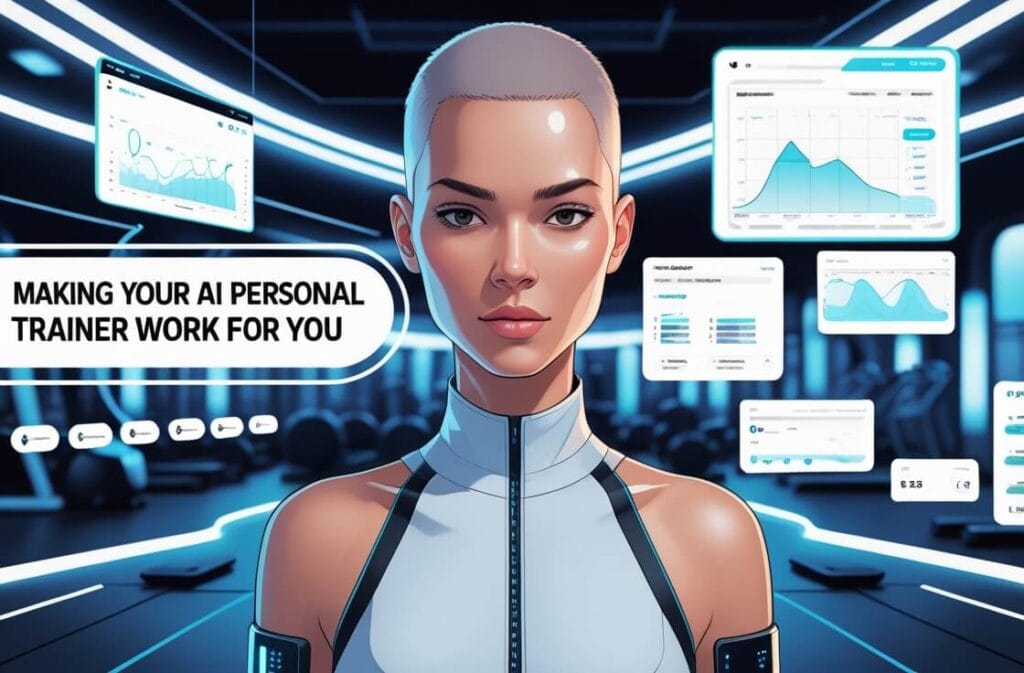
Okay, so you’ve been using an AI personal trainer for a few months and you’re past the beginner phase. Here’s how to really optimize the experience and get even better results.
Experiment with Different Training Styles
One advantage of AI fitness coaches is how easily you can try different approaches. I went through a powerlifting phase, then tried bodybuilding-style training, then got into functional fitness. My AI personal trainer adapted to each style, and the variety kept me from getting bored and plateauing.
Don’t feel locked into one methodology forever. The AI can handle whatever you want to focus on, so use that flexibility. I usually run 8-12 week training blocks focusing on different goals, then reassess.
Be Strategic About Deload Weeks
Most quality AI personal trainers program deload weeks automatically, but you can also request them if you’re feeling beat up. I learned to trust my body more than the algorithm sometimes. If I’m genuinely exhausted despite what the AI thinks I should be capable of, I override it and take an extra recovery day.
The best AI fitness coaches let you provide feedback that influences future programming. After several months, your AI personal trainer will learn your recovery patterns and dial in the periodization better.
Combine Multiple AI Tools
I use different AI personal trainers for different purposes. One for strength programming, another for running, and a separate app for mobility work. They don’t all need to be expensive – mixing one premium AI fitness coach with free supplementary apps works great.
Just make sure the total training volume makes sense across all platforms. I track everything in a simple spreadsheet to avoid accidentally overtraining by following too many programs simultaneously.
Use the Community Features
Even though AI personal trainers are digital, many have active communities where real people share experiences, tips, and motivation. I was skeptical at first but actually made some good online workout buddies through my AI fitness app’s community.
Some platforms have challenges where groups of users compete in AI-designed competitions. It adds a fun element and pushes you to show up consistently.
Periodically Reassess Your Goals
Your AI personal trainer is only as good as the goals you give it. Every 2-3 months, I sit down and honestly evaluate whether my current programming still aligns with what I actually want. Sometimes my goals shift, and I need to update my AI fitness coach accordingly.
Don’t just blindly follow the program forever. You’re in control – the AI is just a tool.
Track Non-Workout Metrics
The more data you give your AI personal trainer, the better it performs. Beyond just logging workouts, I track:
- Sleep quality and duration
- Stress levels
- Energy throughout the day
- Soreness and recovery
- Mood and motivation
Most AI fitness coaches have options to log this stuff, and it helps the algorithm understand the bigger picture of your life and adjust training appropriately.
Don’t Be Afraid to Override the AI
Sometimes the AI programs a workout that just doesn’t fit your day. Maybe it’s too long, or requires equipment you don’t have access to, or just doesn’t appeal to you. Swap it out!
The best AI personal trainers make it easy to substitute exercises or entire workouts without breaking your program. I probably override the default workout 1-2 times per week based on how I’m feeling or what equipment is available at my gym.
Use Progressive Overload Principles
Even though your AI fitness coach handles this automatically, understanding the principle helps you evaluate if the programming makes sense. You should be gradually doing more over time – either more weight, more reps, more sets, or better form.
If your AI personal trainer has you doing the same exact workout for weeks without progression, that’s a red flag. Quality AI personal trainers systematically increase difficulty.
Film Your Workouts Occasionally
Even with AI form checking, I like to occasionally film myself doing key exercises and review the footage. Sometimes I notice things the AI missed, or I want a human trainer’s opinion on my technique.
Some AI personal trainers even let you upload video for analysis, which combines the best of both worlds.
Stay Updated on App Updates
AI fitness technology improves constantly. Your AI personal trainer probably releases updates regularly with new features, better algorithms, and improved form checking. Keep your app updated and explore new features as they’re released.
I’ve been using the same AI fitness coach for two years, and it’s dramatically better now than when I started. The AI learns both from my personal data and from millions of users, so it keeps getting smarter.
Is an AI Personal Trainer Right for You?
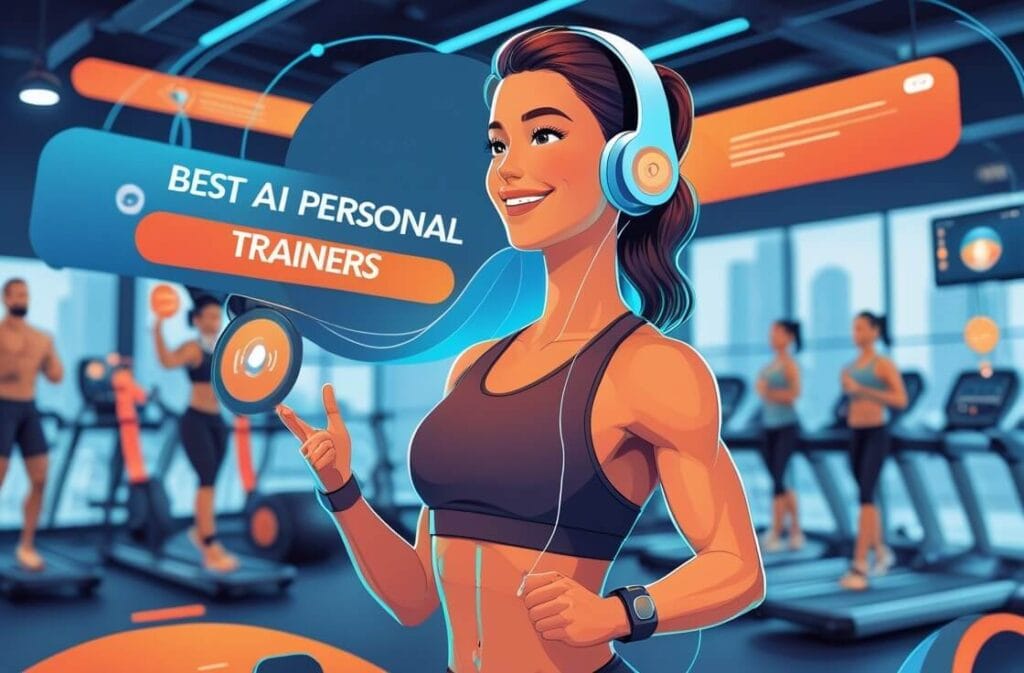
After spending almost two years fully immersed in the world of AI personal trainers, here’s what I know for sure: this technology is legit, and it’s only getting better. Whether you’re trying to lose weight, build muscle, train for a marathon, or just move your body more consistently, there’s an AI fitness coach out there that can help.
The cost savings compared to traditional personal training are impossible to ignore. Even the premium AI personal trainers cost less per month than a single session with a human trainer in most cities. For most people, that makes the decision pretty straightforward – you can either afford consistent AI guidance or occasional human coaching. I know what I’d choose.
But here’s the thing that surprised me most: I actually prefer my AI personal trainer to the human trainers I’ve worked with. There, I said it! The consistency, the data-driven programming, the 24/7 availability, and the lack of weird gym small talk all work better for my personality. Your mileage may vary – some people genuinely need that human connection, and that’s completely valid.
The technology isn’t perfect yet. Form checking is good but not flawless. The motivational aspect feels slightly artificial sometimes. And there are definitely situations where human expertise is irreplaceable. But for everyday fitness goals? AI personal trainers absolutely deliver results if you show up and do the work.
My advice: Just start. Pick an AI fitness coach with a free trial, commit to 4-6 weeks, and see how it feels. You’re not marrying the app – you can always switch or go back to traditional training if it doesn’t work. But I bet you’ll be surprised at how effective these AI personal trainers actually are when you give them a real shot.
The future of fitness is clearly hybrid – AI handling the programming, tracking, and day-to-day coaching, with humans available for specialized guidance, motivation, and that irreplaceable personal touch when you need it. We’re living in a pretty cool time where world-class coaching methodology is available to basically anyone with a smartphone.

